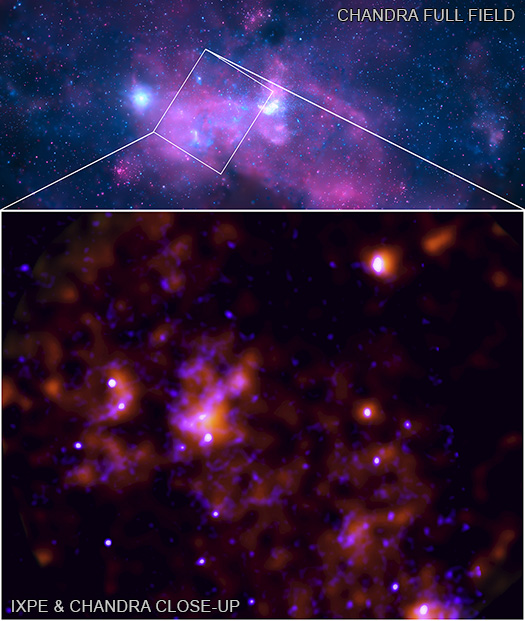Milky Way's Central Black Hole Woke Up 200 Years Ago, NASA's IXPE Finds

Sagittarius A* / Galactic Center
Credit: Chandra: NASA/CXC/SAO; IXPE: NASA/MSFC/F. Marin et al; Image Processing: L.Frattare, J.Major & K.Arcand; Sonification: NASA/CXC/SAO/K.Arcand, SYSTEM Sounds (M. Russo, A. Santaguida)
These images show X-ray data of the area around the supermassive black hole at the center of the Milky Way galaxy. New data from NASA’s Imaging X-ray Polarimetry Explorer (IXPE) has provided evidence that this black hole — known as Sagittarius A* (Sgr A*) — had an outburst about 200 years ago after devouring gas and dust within its reach.
The IXPE data are shown in the bottom panel (orange) and have been combined with other X-ray data from NASA’s Chandra X-ray Observatory (blue). The top panel is a much wider field-of-view of the center of the Milky Way from Chandra. In this image, low and high-energy X-rays are represented by blue and purple colors.
The IXPE data was obtained in February and March 2022 and shows X-ray emission from clouds of gas (called “molecular clouds”) near Sgr A*. A team of scientists used the IXPE data to conclude that these molecular clouds, which are usually cold and dark, were bright in X-rays because they were reflecting X-rays generated elsewhere in the past — a phenomenon known as a “light echo”.
By combining the IXPE data with data from Chandra and XMM, the researchers were able to isolate the reflected X-ray signal and track down its source. They determined that the light originated from or near Sgr A* during an outburst approximately 200 years ago. If the outburst came from Sgr A* it may have been caused by the black hole abruptly consuming material from the molecular clouds.
Sonification Credit: NASA/CXC/SAO/K.Arcand, SYSTEM Sounds (M. Russo, A. Santaguida)
The IXPE team plans to continue its observations of Sgr A*, which will help provide a better understanding of how active the Milky Way’s supermassive black hole was in the past. They are eager to learn the history of such outbursts and whether these are typical events or unique and rare.
These results appear in a paper published in the current issue of the journal Nature by Frederic Marin and colleagues. In addition, a new sonification of these data are being released simultaneously, which translates these new X-ray data from IXPE and Chandra into sounds. This sonification is available at: https://chandra.si.edu/photo/2023/gcenter/animations.html
IXPE is a collaboration between NASA and the Italian Space Agency with partners and science collaborators in 12 countries. IXPE is led by Marshall. Ball Aerospace, headquartered in Broomfield, Colorado, manages spacecraft operations together with the University of Colorado's Laboratory for Atmospheric and Space Physics in Boulder.
NASA's Marshall Space Flight Center manages the Chandra program. The Smithsonian Astrophysical Observatory's Chandra X-ray Center controls science operations from Cambridge, Massachusetts, and flight operations from Burlington, Massachusetts.
Please note this is a moderated blog. No pornography, spam, profanity or discriminatory remarks are allowed. No personal attacks are allowed. Users should stay on topic to keep it relevant for the readers.
Read the privacy statement
